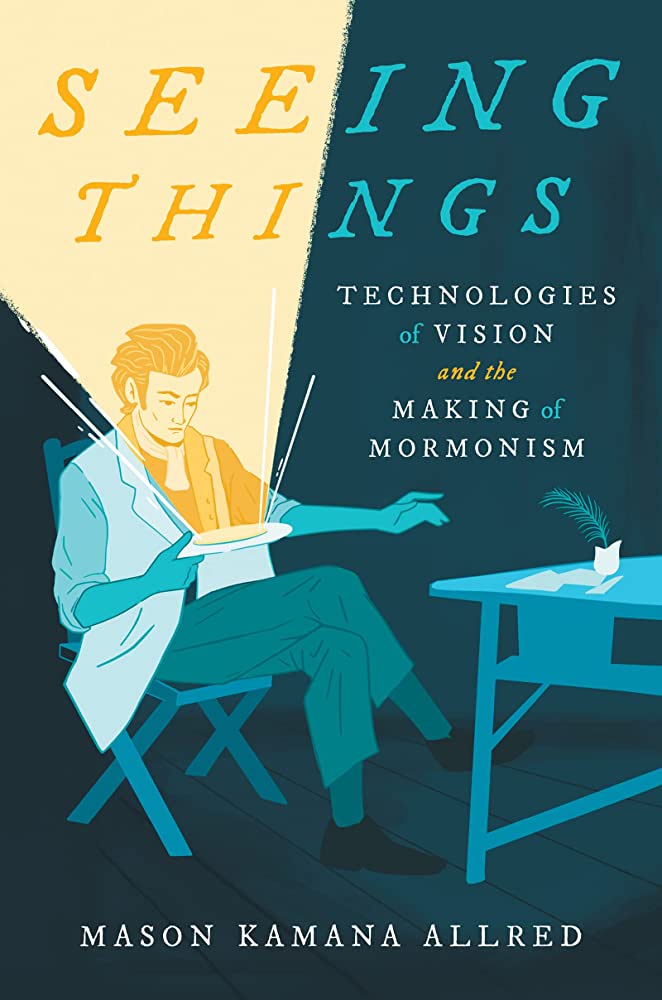Review
———-
Title: Seeing Things: Technologies of Vision and the Making of Mormonism
Author: Mason Kamana Allred
Publisher: University of North Carolina Press
Genre: Religious Non-fiction
Year Published: 2023
Number of Pages: 254
Binding: Trade Paperback
ISBN: 9781469672588
Price: $29.95
Reviewed by Kevin Folkman for the Association for Mormon Letters
Mason Kamana Allred’s book, Seeing Things: Technologies of Vision and the Making of Mormonism, opens with the sentence, “Mormonism began with visions of the dead,” and ends with the phrase, “Mormons are fashioned by looking at stuff to see things.” Between these statements, Allred leads readers through a wide-ranging exploration of how visual media played a role in the establishment and growth of the Church of Jesus Christ of Latter-day Saints.
I struggled through the first few chapters as Allred lays out a thesis based on his study of German media theory and media archaeology, ideas that are not familiar to the average reader. There was a lot of academic phraseology, such as “…not trying to out-Kitler Kitler,” or “one is reminded of …” (insert some other academic’s name that those outside media theory are not likely to recognize). Some word choices were questionable[i].
But I stuck with it. I finally got accustomed to the rhythm of Allred’s writing as he dropped much of the “inside baseball” terminology, and I began to “see” what Allred had been getting at. Visual media, whether handwritten copies of revelations, scriptural texts, or microfilm readers at the Church’s family history libraries, have been key to spreading the Church’s messages and highlighting “…how media were employed to discipline, train, and maintain Mormons as individual bodies and a community” [p15].
In the earliest days of the Church, print media was the primary means of disseminating the visions of Joseph Smith, allowing followers to see with their spiritual eyes by reading with their biological eyes. Readers were encouraged to become “seers,” experiencing for themselves the richness of having their own spiritual experiences. Reading scriptures for spiritual insights continues to be an important principle of LDS doctrine and practice, provoking “…spiritual visions through rational practices” [p33].
Later, Allred writes, Philo Dibble’s and C. C. A. Christensen’s traveling dioramas featuring paintings of events from church history sewn together in large scrolls and serving a similar function. Using images including The First Vision, the martyrdom of Joseph and Hyrum Smith, and the trek west to Utah, their dioramas were moved from town to town in the 19th century. These public showings, equivalent to today’s cinema, were major events throughout the Mormon corridor. Allred writes that “History became image and was thereby converted into a collective memory through a collective practice” [p47].
Allred explains how different technologies were used to maintain boundaries and promote standards of behavior. Chapters are devoted to photography, gendered usage of typewriters (women typed men’s words), the Church’s first attempt at a movie portraying its founding, and other efforts using visual media to reinforce teaching and obedience to religious standards.
Broadcasting, adhering to accepted technology standards, became a means of helping members to maintain Church moral and behavioral standards. Television in particular also served as something of a “…thief in the night” by allowing competing worldly standards into member’s homes [p167]. This dualistic nature of media continues to be a topic of discussion down to the present, magnified by the proliferation of internet access via mobile phones, which Apostle Dieter F. Uchtdorf has likened to seer stones in the hands of church members.
Allred includes many anecdotes regarding spiritual experiences of members doing genealogical research using microfilm readers, where the visual media displayed on the reader’s screen prompted users’ own episodes of revelation in finding otherwise hidden clues to links in researchers’ ancestry. He also likens the practice of early television reception that required audiences to “tune in” by selecting the correct channel and adjusting antennas and other controls to receive the proper message with the Church’s encouragement to be “in tune with the Holy Ghost.” Church correlation in the 20th century becomes a vehicle for enforcing standards of “seeing” the correct visions. As the Church moved towards assimilation into the broader American culture, Church media reflected the gender-specific roles, American patriotism, and wholesome family values of the times.
But demographics changed in the latter half of the 20th century, and some of the traditional means of seeing things became more difficult. The LDS Church is no longer primarily a Utah-based or even predominately North American denomination. Competing narratives of the Church’s history became just as available as the “authorized” versions. Gender and racial issues moved from the shadows into the forefront. New strategies to manage how members see things seems to be the order of the day. As Allred notes:
By taking stock of their past and present media entanglements, Latter-day Saints might generate new horizons of inclusion and sever problematic ties to harmful or dangerously limited visions…[revealing] a tendency toward using media visions in an effort to survive assimilation into American mainstream culture. [p189]
I found Seeing Things difficult to navigate in my early reading, struggling with the academic nature of Allred’s writing. I fear that for some Allred’s vision might be obscured, and they may miss what he thinks is important and wants us to see. Seeing Things presents interesting ideas and a new way of looking at our history.
[i] For example, Allred uses “lacunae” instead of the simpler word “gaps” to describe lapses in our recorded history and “imbrication” to describe overlapping images and patterns in visual media.

